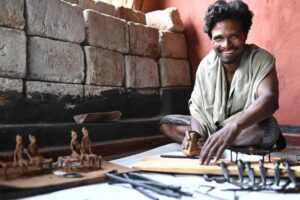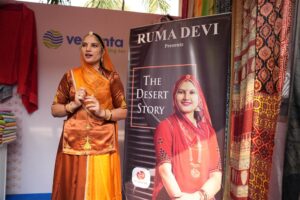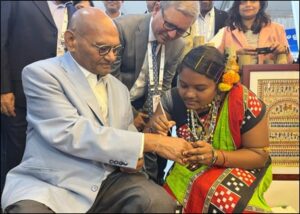In the heartlands of India, where dusty trails wind through sun-baked villages and age-old hills whisper centuries of stories, art has always been more than an aesthetic. It is a voice, an identity, and a tradition passed down through generations like a treasured heirloom. In Odisha and Rajasthan, the millennia-old crafts of Dhokra metalwork, Saura paintings, Ajrak block-printing, and Appliqué embroidery have long defined the cultural fabric of the communities that nurture them. Yet, with the rapid tide of modernity sweeping through these regions, many of these cherished artforms began to fade. That is, until a determined intervention by Vedanta infused them with renewed purpose — transforming them into engines of empowerment and symbols of resilience.
Through inclusive community programs such as Project Adikala, Upaya, and partnerships with changemakers like Ruma Devi, Vedanta has redefined the trajectory of countless artisans. By preserving these time-honoured traditions and transforming them into sustainable livelihoods, the company has ensured that today, these crafts flourish—as do the communities behind them.
A Tapestry of Traditions
 Picture the Jaipur Literature Festival, a confluence of global minds and ideas under vibrant canopies. Amid the intellectual buzz, another form of storytelling quietly captivates visitors: glinting Dhokra figurines, the hypnotic geometry of Saura art, richly dyed Ajrak prints, and intricate appliqué work. Every weft and warp breathes history. Behind these artworks stand artisans nurtured by Vedanta’s initiatives — no longer anonymous but celebrated custodians of cultural legacy.
Picture the Jaipur Literature Festival, a confluence of global minds and ideas under vibrant canopies. Amid the intellectual buzz, another form of storytelling quietly captivates visitors: glinting Dhokra figurines, the hypnotic geometry of Saura art, richly dyed Ajrak prints, and intricate appliqué work. Every weft and warp breathes history. Behind these artworks stand artisans nurtured by Vedanta’s initiatives — no longer anonymous but celebrated custodians of cultural legacy.

Uanshu Kansari
Uanshu Kansari, a Dhokra metalsmith from Kankeri village in Odisha’s Kalahandi district, recalls watching his grandfather meticulously shape brass and bell metal, only to sell the intricate pieces to middlemen for meagre returns. “We survived, but just barely,” he says. “When Vedanta came, they introduced us to new designs, connected us directly with buyers, and gave us platforms at national exhibitions. Now, my idols and figurines travel to Bhubaneswar, Delhi, and even international events. From earning ₹4,000 a month, my income has increased tenfold to ₹40,000,” he shares, eyes gleaming with pride.
In Rajasthan, Hindustan Zinc, through its Sakhi initiative, is breathing life back into Ajrak — a 4,500-year-old block-printing art—via the skilled hands of rural women known as Sakhi Didis. With support from Vedanta and the apparel brand Upaya, what was once limited to local bazaars now reaches buyers across India through digital platforms, telling tales of resilience and cultural resurgence.
Ishana Kumari, an artisan from a block-printing unit in Ajmer, reflects, “Block printing is not just an art — it’s a legacy passed down through generations. Before joining the Sakhi training centre, I never imagined I could be part of reviving something so rich. Today, every design I make feels like a tribute to our roots. I’m deeply thankful to Vedanta’s Hindustan Zinc. It’s not just training — it’s empowerment. Through Sakhi, I’ve gained confidence, livelihood skills, and a sense of purpose.”
Echoing her sentiment, Sharmila Devi, also from Ajmer, shares, “I had always admired block-printed fabrics but never dreamed I’d one day create them. Thanks to Sakhi, I’ve found a new identity. With every block I print, I feel stronger, more confident, and inspired.”
 Ruma Devi, a grassroots leader from Barmer, began her journey with a single needle and unwavering determination. “We made appliqué work only for our homes,” she recalls. “With support from Vedanta Cairn, we trained hundreds of women, developed fashion lines, and took our art to national and international platforms. We were once invisible; today, we are business owners, artists, and mentors.” Now, Ruma Devi is the face of contemporary appliqué design at global showcases.
Ruma Devi, a grassroots leader from Barmer, began her journey with a single needle and unwavering determination. “We made appliqué work only for our homes,” she recalls. “With support from Vedanta Cairn, we trained hundreds of women, developed fashion lines, and took our art to national and international platforms. We were once invisible; today, we are business owners, artists, and mentors.” Now, Ruma Devi is the face of contemporary appliqué design at global showcases.
Taking Art Beyond Boundaries
Vedanta believes that traditional art belongs not just in museums, but in everyday life. Artisans trained through its initiatives now regularly showcase their talents at prestigious events such as the Vedanta Dilli Haat Culture Festival, Jaigarh Heritage Festival, Rising Rajasthan, Make in Odisha Conclave, and the International Aluminium Conference.

Nimanti tatooing a saura motif on Vedanta Chairman Anil Agarwal’s hand
Nimanti Majhi, a Saura artist, transforms hands into living canvases by tattooing tribal motifs on corporate leaders and dignitaries. “People stop, ask about my work, buy my art, and take my contact details. I never imagined my village paintings would travel so far,” she says, smiling.
To further elevate Indian artisans globally, the Anil Agarwal Riverside Studios in London is set to become a vibrant cultural hub. It will offer Indian artists a global platform, fostering creative expression that transcends geographical boundaries.
A Movement Backed by Numbers
In Lanjigarh’s Kankeri and neighbouring villages, over 70 artisans actively practise Dhokra and Saura art. More than 150 schoolchildren are learning Saura painting, sowing seeds of creativity and cultural pride for the next generation. Since 2018, artisan incomes have risen by over 50%. The initiative has spawned more than 300 designs and 21 product categories under the Kalahandi Craft brand. Alongside artistic revival, infrastructure development has followed — piped water, roads, and basic amenities now reach these rural communities, making development holistic.
A Garden of Expression
As World Art Day 2025 celebrates the theme “A Garden of Expression: Cultivating Community Through Art,” Vedanta stands tall as one of its most committed cultivators. In this garden, tradition flourishes, livelihoods grow, and stories of resilience blossom—etched into every crafted piece. By reconnecting communities with their heritage, Vedanta is not just preserving the past; it is helping shape a more empowered future.
Vedanta Limited, a subsidiary of Vedanta Resources Limited, is one of the world’s leading natural resources companies. With operations across India, South Africa, Namibia, Liberia, UAE, Korea, Taiwan, and Japan, it is active in Oil & Gas, Zinc, Lead, Silver, Copper, Iron Ore, Steel, Nickel, Aluminium, Power, and Glass Substrate. It is also making inroads into semiconductors and display glass. For over two decades, Vedanta has significantly contributed to nation building, with governance, health, safety, environmental sustainability, and inclusive growth at the core of its strategy.
 The Business Bytes
The Business Bytes